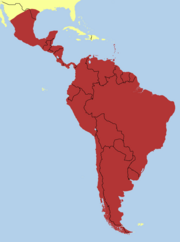| Megaceryle | |
|---|---|

| |
| A male belted kingfisher (Megaceryle alcyon) | |
| Scientific classification | |
| Domain: | Eukaryota |
| Kingdom: | Animalia |
| Phylum: | Chordata |
| Class: | Aves |
| Order: | Coraciiformes |
| Family: | Alcedinidae |
| Subfamily: | Cerylinae |
| Genus: | Megaceryle Kaup, 1848 |
| Type species | |
| Alcedo guttatus Vigors, 1831 | |
| Species | |
|
M. maxima | |
| Phylogeny | |||||||||||||||||||||
| |||||||||||||||||||||
| Cladogram based on Andersen et al. (2017) |
Megaceryle is a genus of very large kingfishers. They have a wide distribution in the Americas, Africa, and Southeast Asia.
The genus was erected by German naturalist Johann Jakob Kaup in 1848. The type species is a subspecies of the crested kingfisher, Megaceryle lugubris guttulata. Megaceryle is from the Ancient Greek megas, "great", and the existing genus Ceryle.
Species
The genus comprises four species:
| Common name | Scientific name and subspecies | Range | Size and ecology | IUCN status and estimated population |
|---|---|---|---|---|
| Crested kingfisher | Megaceryle lugubris (Temminck, 1834) Four subspecies |
northern India, Bangladesh, northern Indochina, Southeast Asia, and Japan
|
Size: Habitat: Diet: |
LC
|
| Giant kingfisher | Megaceryle maxima (Pallas, 1769) Two subspecies
|
Liberia to northern Angola and western Tanzania, island of Bioko, Senegal, and Gambia to Ethiopia and south to South Africa
|
Size: Habitat: Diet: |
LC
|
| Ringed kingfisher | Megaceryle torquata (Linnaeus, 1766) Three subspecies
|
Southeastern most Texas in the United States through Central America to Tierra del Fuego in South America
|
Size: Habitat: Diet: |
LC
|
| Belted kingfisher | Megaceryle alcyon (Linnaeus, 1758) |
North America, within Canada, Alaska, and the United States
|
Size: Habitat: Diet: |
LC
|
All are specialist fish-eaters with prominent stiff crests on their heads. They have dark grey or bluish-grey upperparts, largely unmarked in the two American species, but heavily spotted with white in the Asian crested kingfisher and the African giant kingfisher. The underparts may be white or rufous, and all forms have a contrasting breast band except male ringed kingfisher. The underpart pattern is always different for the two sexes of each species.
These birds nest in horizontal tunnels made in a river bank or sand bank. Both parents excavate the tunnel, incubate the eggs, and feed the young.
Megaceryle kingfishers are often seen perched prominently on trees, posts, or other suitable watch-points close to water before plunging in headfirst after their prey, usually fish, crustaceans, or frogs, but sometimes aquatic insects and other suitably sized animals.
Origins and taxonomy
The previous view that the Megaceryle kingfishers arose in the New World from a specialist fish-eating alcedinid ancestor that crossed the Bering Strait and gave rise to this genus and the American green kingfishers Chloroceryle, with a large crested species later, in the Pliocene, crossing the Atlantic Ocean to give rise to the giant and crested kingfishers is probably wrong. Rather, it now seems that the genus probably originates in the Old World, possibly Africa, and the ancestor of the belted and ringed kingfishers made the ocean crossing
The Megaceryle kingfishers were formerly placed in Ceryle with the pied kingfisher, but the latter is genetically closer to the American green kingfishers.
References
- Andersen, M.J.; McCullough, J.M.; Mauck III, W.M.; Smith, B.T.; Moyle, R.G. (2017). "A phylogeny of kingfishers reveals an Indomalayan origin and elevated rates of diversification on oceanic islands". Journal of Biogeography. 45 (2): 1–13. doi:10.1111/jbi.13139.
- Kaup, Johann Jakob (1848). "Die Familie der Eisvögel (Alcedidae)". Verhandlungen des Naturhistorischen Vereins für das Großherzogthum Hessen und Umgebung (in German). 2: 68. OCLC 183221382.
- Peters, James Lee, ed. (1945). Check-list of Birds of the World. Volume 5. Vol. 5. Cambridge, Massachusetts: Harvard University Press. p. 165.
- Jobling, James A (2010). The Helm Dictionary of Scientific Bird Names. London: Christopher Helm. pp. 245. ISBN 978-1-4081-2501-4.
- Gill, Frank; Donsker, David, eds. (2017). "Rollers, ground rollers & kingfishers". World Bird List Version 7.2. International Ornithologists' Union. Retrieved 17 May 2017.
- C. H. Fry & Kathie Fry; illustrated by Alan Harris (2000). Kingfishers, Bee-eaters and Rollers. Princeton University Press. ISBN 0-691-04879-7.
- Moyle, Robert G. (2006). "A molecular phylogeny of kingfishers (Alcedinidae) with insights into early biogeographic history". Auk. 123 (2): 487–499. doi:10.1642/0004-8038(2006)123[487:AMPOKA]2.0.CO;2. hdl:1808/16596.
| Water kingfishers | |
|---|---|
| |
| Megaceryle |
|
| Ceryle |
|
| Chloroceryle |
|
| 9 living species in 3 genera | |
| Taxon identifiers | |
|---|---|
| Megaceryle | |















